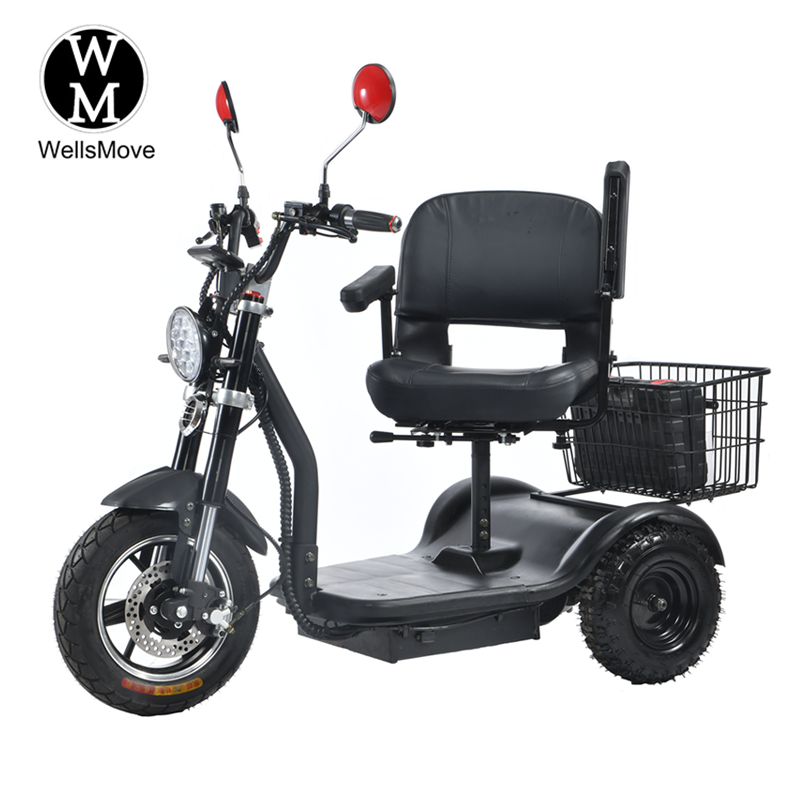Full analysis of the climbing ability test of the elderly three-wheeled scooter
Introduction
With the deepening of the global aging population, the market demand for elderly three-wheeled scooters is growing. For international wholesale buyers, it is crucial to understand the various performance indicators of elderly three-wheeled scooters, and climbing ability, as one of the key factors to measure its performance, is directly related to the applicability and reliability of the vehicle in actual use. This article will explore the climbing ability test of the elderly three-wheeled scooter in depth to help buyers better choose the right product.
1. The importance of climbing ability
Adapting to diverse road conditions: Elderly people may encounter a variety of road conditions when traveling, including slopes, gentle slopes, etc. Elderly three-wheeled scooters with good climbing ability can easily cope with these road conditions, ensuring that the elderly will not be restricted by the slope of the road when traveling, thereby improving their convenience and autonomy in travel.
Safety considerations: During the climbing process, the stability and braking performance of the vehicle are crucial. If the climbing ability of the scooter is insufficient, dangerous situations such as slipping and sliding may occur on the slope, posing a threat to the personal safety of the elderly. Vehicles that have undergone rigorous gradeability testing can remain stable when climbing, effectively avoiding such safety accidents.
Scope of use: Elderly three-wheeled scooters with strong gradeability can be used in more scenarios, such as entering communities, parks, and shopping mall parking lots with slopes. On the contrary, vehicles with poor gradeability may limit the range of activities of the elderly, making it impossible for them to smoothly reach some places that require ramps, thereby reducing the practicality and cost-effectiveness of the scooter.
2. Gradeability testing standards and methods
Testing standards: At present, there may be differences in the gradeability testing standards for elderly three-wheeled scooters in different regions and countries. Generally speaking, common testing standards include the maximum gradeability of the vehicle under full load or specified load. For example, some standards require that the scooter can continuously travel a certain distance on a slope with a certain slope, such as 5 meters, without stopping or sliding back.
Testing methods: Professional testing equipment and venues are usually used for gradeability testing. During the test, the scooter is placed on a test bench simulating different slopes, and then the vehicle is driven uphill at different speeds and gears. The performance of the vehicle during the climbing process is observed and recorded, such as whether it successfully climbs to the top of the slope, whether there is insufficient power or abnormal shaking, etc. At the same time, the braking performance of the vehicle is also tested to ensure that the vehicle can stop quickly and stably during emergency braking during the climbing process.
3. Factors affecting climbing ability
Motor performance: The motor is the power source of the elderly three-wheeled scooter, and its power and torque directly affect the vehicle’s climbing ability. High-power and high-torque motors can provide stronger power output, giving the vehicle more advantages when climbing. For example, an Entu E9 elderly scooter equipped with a 3000W permanent magnet synchronous high-torque motor has a maximum climbing degree of 18 degrees, showing good climbing performance.
Battery type and endurance: The voltage and capacity of the battery also have a certain impact on the climbing ability of the scooter. Generally speaking, the higher the voltage and the larger the capacity of the battery, the more energy it can provide to the motor, making the vehicle more powerful when climbing a slope, while also ensuring a certain range. For example, a 60V lithium battery usually has better power performance when climbing a slope than a 48V lead-acid battery.
Vehicle weight and center of gravity distribution: The vehicle’s curb weight and center of gravity position will affect its stability and power requirements when climbing a slope. Lighter vehicles require relatively less power when climbing a slope, and vehicles with a reasonable center of gravity distribution can better maintain balance and prevent overturning during climbing. Therefore, when designing and manufacturing elderly three-wheeled scooters, it is necessary to fully consider the weight and center of gravity distribution of the vehicle to optimize its climbing performance.
Tire type and air pressure: The friction between the tire and the ground is one of the key factors affecting the vehicle’s climbing ability. Wide tires or tires with deep patterns can provide greater friction, enhance the vehicle’s grip when climbing a slope, and thus improve climbing ability. In addition, it is also very important to maintain proper tire pressure. Too low or too high pressure will affect the contact effect and friction between the tire and the ground.
Transmission system efficiency: An efficient transmission system can transmit the power of the motor to the wheels more effectively, reduce energy loss, and thus improve the vehicle’s climbing ability. If there are problems such as wear, looseness or poor lubrication in the transmission system, it will cause the power transmission to be unsmooth, affecting the climbing performance of the scooter.
4. Actual cases and data analysis of climbing ability test
Case 1: Taking a certain brand of elderly three-wheeled scooters as an example, when testing its climbing ability, first build test ramps with different slopes in the laboratory environment, which are 6 degrees, 9 degrees, 12 degrees and 15 degrees. Then let the vehicle perform climbing tests at different speed gears. The test results show that the scooter can easily climb up the 6-degree and 9-degree slopes and has stable driving; on the 12-degree slope, it performs well when climbing at a lower speed, but there is a slight lack of power at a high speed; on the 15-degree slope, it cannot climb smoothly and the vehicle slips backwards halfway. Through the analysis of the test data, it is found that the motor performance of the scooter is acceptable when dealing with medium slopes, but there are certain limitations when facing larger slopes.
Case 2: Another elderly three-wheeled scooter was tested for climbing on a representative slope section with a slope of about 10 degrees and a length of 30 meters. During the test, the climbing time, speed change, and stability of the vehicle were recorded when the vehicle was fully loaded and unloaded. The results show that when unloaded, the scooter can climb the slope smoothly at a faster speed, and the vehicle runs smoothly; when fully loaded, although the vehicle can still climb the slope, the speed is reduced, and the running sound of the motor increases slightly during the climbing process. Through the analysis of this case, we can have a more intuitive understanding of the climbing ability of the scooter under different load conditions, and also provide a practical basis for further optimizing the performance of the vehicle.
5. Strategies and suggestions for improving the climbing ability of elderly three-wheeled scooters
Optimize motor design: Develop higher-performance motors, improve the power and torque output of the motor, and pay attention to the heat dissipation performance and reliability of the motor to ensure that it can continuously and stably provide strong power when climbing.
Use advanced battery technology: Select batteries with higher energy density and longer endurance, and reasonably configure the voltage and capacity of the battery pack to meet the vehicle’s energy needs when climbing, while reducing the weight of the battery pack itself and improving the overall performance of the vehicle.
Optimize vehicle structure and center of gravity distribution: During the vehicle design stage, reduce the vehicle’s curb weight through reasonable structural layout and material selection, and optimize the center of gravity distribution, so that the vehicle is more stable when climbing and reduces the demand for power. For example, use lightweight but high-strength body materials, and reasonably arrange the positions of various components in the vehicle.
Choose suitable tires: According to the vehicle’s usage scenarios and design requirements, choose tires with moderate width, reasonable patterns and stable air pressure to increase the friction and grip between the vehicle and the ground and enhance the climbing ability. At the same time, regularly check and maintain the tires to ensure that they are in good use.
Improve the efficiency of the transmission system: Strengthen the research and development and improvement of the transmission system, adopt efficient transmission components and lubrication technology, reduce the loss of power during transmission, improve the reliability and durability of the transmission system, and thus improve the vehicle’s climbing ability.
6. Summary
The climbing ability of the elderly three-wheeled scooter is one of the important indicators to measure its performance and quality, which is directly related to the travel experience and safety of the elderly. Through strict and standardized climbing ability tests, the performance of vehicles under different slope conditions can be accurately evaluated, providing a strong basis for international wholesale buyers to choose suitable products. At the same time, understanding the various factors that affect climbing ability and adopting effective improvement strategies are of great significance to promoting the technological progress and market development of elderly three-wheeled scooters. In the future, with the continuous innovation and development of technology, it is believed that the climbing ability of elderly three-wheeled scooters will be further improved, providing a safer, more convenient and reliable travel option for the elderly.
Post time: May-19-2025



